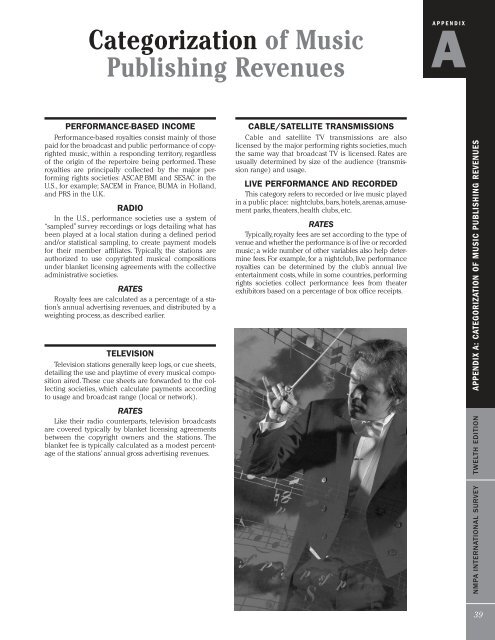NMPA_International_Survey_12th_Edition
NMPA_International_Survey_12th_Edition
NMPA_International_Survey_12th_Edition
Create successful ePaper yourself
Turn your PDF publications into a flip-book with our unique Google optimized e-Paper software.
Categorization of Music<br />
Publishing Revenues<br />
APPENDIX<br />
A<br />
PERFORMANCE-BASED INCOME<br />
Performance-based royalties consist mainly of those<br />
paid for the broadcast and public performance of copyrighted<br />
music, within a responding territory, regardless<br />
of the origin of the repertoire being performed. These<br />
royalties are principally collected by the major performing<br />
rights societies: ASCAP,BMI and SESAC in the<br />
U.S.,for example; SACEM in France, BUMA in Holland,<br />
and PRS in the U.K.<br />
RADIO<br />
In the U.S., performance societies use a system of<br />
“sampled” survey recordings or logs detailing what has<br />
been played at a local station during a defined period<br />
and/or statistical sampling, to create payment models<br />
for their member affiliates. Typically, the stations are<br />
authorized to use copyrighted musical compositions<br />
under blanket licensing agreements with the collective<br />
administrative societies.<br />
RATES<br />
Royalty fees are calculated as a percentage of a station’s<br />
annual advertising revenues, and distributed by a<br />
weighting process, as described earlier.<br />
TELEVISION<br />
Television stations generally keep logs,or cue sheets,<br />
detailing the use and playtime of every musical composition<br />
aired.These cue sheets are forwarded to the collecting<br />
societies, which calculate payments according<br />
to usage and broadcast range (local or network).<br />
RATES<br />
Like their radio counterparts, television broadcasts<br />
are covered typically by blanket licensing agreements<br />
between the copyright owners and the stations. The<br />
blanket fee is typically calculated as a modest percentage<br />
of the stations’ annual gross advertising revenues.<br />
CABLE/SATELLITE TRANSMISSIONS<br />
Cable and satellite TV transmissions are also<br />
licensed by the major performing rights societies,much<br />
the same way that broadcast TV is licensed. Rates are<br />
usually determined by size of the audience (transmission<br />
range) and usage.<br />
LIVE PERFORMANCE AND RECORDED<br />
This category refers to recorded or live music played<br />
in a public place: nightclubs,bars,hotels,arenas,amusement<br />
parks, theaters, health clubs, etc.<br />
RATES<br />
Typically,royalty fees are set according to the type of<br />
venue and whether the performance is of live or recorded<br />
music; a wide number of other variables also help determine<br />
fees. For example, for a nightclub, live performance<br />
royalties can be determined by the club’s annual live<br />
entertainment costs, while in some countries, performing<br />
rights societies collect performance fees from theater<br />
exhibitors based on a percentage of box office receipts.<br />
<strong>NMPA</strong> INTERNATIONAL SURVEY TWELTH EDITION APPENDIX A: CATEGORIZATION OF MUSIC PUBLISHING REVENUES<br />
39


